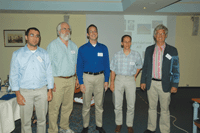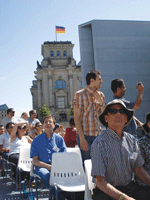Householder XVII: Numerical Linear Algebra on the Lake
October 21, 2008

David Bindel (center), who received the 2008 Householder Award at the Zeuthen meeting, with, from left, Emre Mengi, D. Steven Mackey, and Ivan Markovsky, each awarded honorable mention, and Charlie Van Loan, who chaired the award committee. Photo by Esmond Ng.
J�rg Liesen, Volker Mehrmann, and Reinhard Nabben
The 17th Householder Symposium on Numerical Linear Algebra took place June 1�6, 2008, in Zeuthen, Germany, a small town about 25 kilometers southeast of Berlin. Formerly known as the Gatlinburg Symposia, the Householder Symposia are held every three years to discuss the state of the art in numerical linear algebra; series founder Alston S. Householder was one of the pioneers of the field. The symposia are organized by the permanent international Householder Committee, chaired this year by Angelika Bunse-Gerstner (University of Bremen), and a local arrangements committee, whose members this year were J�rg Liesen, Volker Mehrmann, and Reinhard Nabben (all of TU Berlin). This year's meeting drew 135 participants, with the USA (45), Germany (15), and the UK (14) sending the biggest groups.
Informality is a tradition of the Householder Symposia, and the intermingling of young and established researchers is a priority. Invited plenary talks are given in the morning, and the afternoons are filled with parallel (informal) sessions, individual discussions, and social activities. This year's meeting, held in the lakeside Seehotel Zeuthen, started with a reception on Sunday, June 1; Angelika Bunse-Gerstner and J�rg Liesen opened the official program on Monday morning.
The Householder atmosphere set in early, with the audience engaging in lively exchanges with both of the opening speakers, Chris Paige (McGill University) and Nick Trefethen (Oxford University). Trefethen made it easy, showing numerous live MATLAB computations in his new Chebfun package, for which he distributed handouts with the most important commands at the beginning of the talk. With a paper completed only two days after the end of the meeting, he also holds the unofficial record for the first paper to come out of meeting discussions.
The topics of the plenary talks spanned a wide range of current research trends in numerical linear algebra. Michele Benzi (Emory University), for example, talked about localization phenomena in matrix functions, and Misha Kilmer (Tufts University) presented a multilevel, modified total least norm approach to signal and image deblurring. Spectral problems were a major topic. Howard El-man (University of Maryland) described preconditioners for eigenvalue problems arising in linear stability analysis, Plamen Koev (North Carolina State University), this year's speaker sponsored by the International Linear Algebra Society, presented methods for computing the eigenvalues of random matrices, and Mark Embree (Rice University) discussed spectra, pseudospectra, and structured perturbations of damped mechanical systems. Several other speakers considered structured spectral problems, including Fran�oise Tisseur (University of Manchester), in a talk on detecting and solving hyperbolic quadratic eigenvalue problems, and Daniel Kressner (ETH Z�rich), in a talk on computing structured pseudospectra. The well-attended parallel afternoon sessions were of excellent quality.
Examplifying the informal style of the Householder Symposia, Iain Duff (Rutherford Appleton Laboratory) used his 20-minute slot for a 2-minute talk in which he posed a specific question: What is the rank of the matrix [1 0; 0 1e-16]? Thus encouraged, the audience entered into a discussion of the numerical rank of matrices. MATLAB calls such a matrix "close to singular or badly scaled," Cleve Moler (The MathWorks) pointed out, insisting that more must be known about the source of the matrix before Duff's question can be answered. The discussion concluded with a close examination of a class of matrices Pete Stewart (University of Maryland) called the "monoelemental matrices" (yes, that's the class of 1 x 1 matrices).
A highlight of the symposium was the presentation of the 13th Alston S. House-holder Award to David Bindel (UC Berkeley). The award recognizes the best dissertation in numerical linear algebra submitted by a recipient of a PhD earned between January 1, 2005, and December 31, 2007. Bindel's dissertation, "Structured and Parameter-Dependent Eigensolvers for Simulation-Based Design of Resonant MEMS," was selected by an international committee chaired by Charles Van Loan (Cornell University). Bindel titled his Householder Award talk "Computer-Aided Design of MEMS: Eigenvalues, Energy Losses, and Dick Tracy Watches." The committee awarded honorable mentions to D. Steven Mackey (University of Manchester), Ivan Markovsky (K.U. Leuven), and Emre Mengi (New York University).
Highlights of the social program included a sightseeing trip though Berlin by boat, followed by a barbeque on the hotel's beach. Jim Varah (University of British Columbia), the after-dinner speaker at the traditional Householder dinner, looked back on the Householder Symposia from 1961 until today. Lamentably few photos of the first meetings are available. In recent years, by contrast, many participants come equipped with digital cameras, and several hundred photos of this year's meeting are already available online (http://www3.math.tu-berlin.de/householder_2008/); also available at the Web site is a link to the 200-page Book of Abstracts for this year's symposium.

Sightseeing excursion: A boat ride through Berlin, passing the Reichstag.
Many participants already look forward to Householder XVIII, which will be organized by Esmond Ng (Lawrence Berkeley National Lab) and is scheduled for 2011 in Lake Tahoe.

